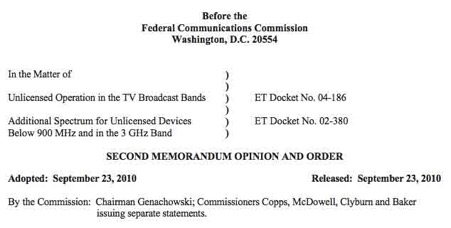TV White Space Decision is Released
23 09, 10 16:52 Filed in: spectrum policy

The FCC discussed and approved this morning the above 2nd Memorandum Opinions and Order resolving questions from the TV white space decision of almost 2 years ago. Oddly, if was released under the hyperbole “FCC Frees Up Vacant TV Airwaves For "Super Wi-Fi" Technologies and Other Technologies”. The document is 79 pages without commissioners’ statements.
Chmn. Genachowski oddly said in his statement, “Today’s Order marks the Commission’s first significant release of unlicensed spectrum in 25 years.” Apparently he overlooked the release of 5 GHz in the 59-64 GHz band (later increased to 7 GHz in 57-64 GHz) in the 12/15/95 Report and Order in Docket 94-124 during his first tenure at the Commission under Chairman Hundt.
The new decision removes the sensing requirement from devices that have geolocation and database access to determine spectrum availability. It keeps the archaic R-6602 definition of where a TV signal is present saying “The current method of calculating TV station contours in Section 73.684 of the rules using the FCC curves in Section 73.699 of the rules is straight forward, well understood and has proven sufficiently accurate over time.” (para. 21) So cities like Monterey, California that are within multiple grade B contours but get little real over-the-air TV service are just out of luck.
It did ease use restrictions near the Canadian and Mexican borders in deference to Native American groups.
It guaranteed at least 2 TV channels in every area for wireless mic use and allows extra use for “Broadway-like” shows and special events if they can show their are no other options.
In response to demands by wireless mic advocates that they get even more spectrum, the Commission stated,
We disagree with those who argue that more spectrum should be reserved for wireless microphones. We observe that wireless microphones generally have operated very inefficiently, perhaps in part due to the luxury of having access to a wealth of spectrum. While there may be users that believe they need access to more spectrum to accommodate more wireless microphones, we find that any such needs must be accommodated through improvements in spectrum efficiency.
blog comments powered by Disqus



![Validate my RSS feed [Valid RSS]](valid-rss-rogers.png)

